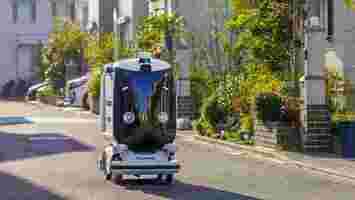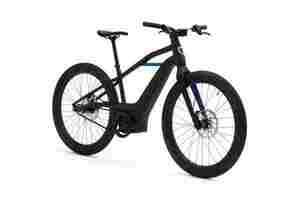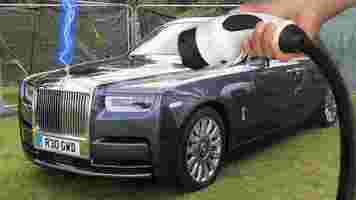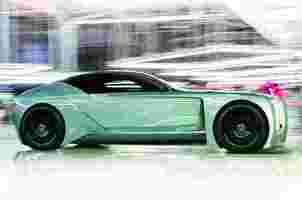Panasonic is testing Japan’s reaction to its first delivery robots
This article was originally published by Sarah Wray on Cities Today , the leading news platform on urban mobility and innovation, reaching an international audience of city leaders. For the latest updates follow Cities Today on Twitter , Facebook , LinkedIn , Instagram , and YouTube , or sign up for Cities Today News.

Panasonic is testing an autonomous delivery robot in Fujisawa Sustainable Smart Town , the six-year-old urban development initiative in Fujisawa City, Kanagawa Prefecture.
The first phase of the trial focused on testing a self-driving robot on public roads, began last month and will last until the end of the year. The second phase, which will start in February 2021, will see the robot provide home deliveries to residents in the area. It aims to “test the acceptability of the new delivery service experience.”
The robot will run on its own and can avoid most obstacles, but it will be monitored remotely by a control center operator, who can take over if necessary. It will travel at a speed of up to four kilometers per hour.
“By offering a new form of delivery service using robots that work closely with humans, [we aim] to contribute to creating a vibrant community where people and mobility coexist,” Panasonic said in a statement.
The company said the pandemic had accelerated the initiative as more people order food and online goods for delivery and require contactless options.
According to Panasonic: “There has been a serious shortage of home delivery staff to support such services.” This hasn’t been the case everywhere in the world , though, as in many countries, COVID-induced unemployment has seen heavy competition for delivery work. It’s early days but there are also broader concerns that autonomous robots could eventually start to eat into human jobs.
In Japan, testing of autonomous vehicles on public roads, including delivery robots, requires a permit from local police.
National strategy
The trials are based on Japan’s growth strategy action plan , published in July 2020, which called for robot delivery pilots to inform policymaking for a wider roll-out.
Panasonic is taking part in a public-private council for the promotion of deliveries by autonomous robots which is sponsored by Japan’s Ministry of Economy, Trade, and Industry. Part of the company’s R&D and field test activities are also being supported by a government technology development project to accelerate the deployment of autonomous delivery technologies.
In October, Japan Post Co. started public road trials of self-driving delivery robots in Tokyo.
Elsewhere, Starship Technologies is running robot deliveries with the Co-op supermarket in two UK cities, with plans to expand the service next year. In July, Amazon announced trials of its electric, autonomous Scout package delivery robots in Atlanta, Georgia, and Franklin, Tennessee, adding to services in Snohomish County , Washington, and Irvine , California.
San Francisco, which was a front-runner for the deployment of robot deliveries, passed regulations in 2017 to govern the use of delivery robots after complaints from some residents. The city has since established an Office of Emerging Technology to engage earlier with companies that want to deploy potentially disruptive new systems and products.
In other robot uses during the pandemic, Singapore piloted a four-legged, dog-like robot called Spot to promote social distancing in parks, and Seoul is using small humanoid robots to deliver digital skills training to senior citizens.
Smart town
Panasonic has been working in Fujisawa Sustainable Smart Town since it opened in 2014. The development, which is home to over 2,000 people, is located on the site of a former Panasonic factory in Fujisawa. It brings together 18 public and private organizations, including Panasonic and Fujisawa City. The community aims to serve as a model for citizen-centric sustainable development and how technology can address urban challenges related to energy, security, mobility, and health.
SHIFT is brought to you by Polestar. It’s time to accelerate the shift to sustainable mobility. That is why Polestar combines electric driving with cutting-edge design and thrilling performance. Find out how .
Gear up: Harley-Davidson’s ebikes are rolling across Europe
I admire Harley-Davidson‘s motorcycles as much as the next person, but the truth is I’m totally incapable of riding one.

So when the iconic brand and its affiliated company, Serial 1 Cycle, released their ebikes back in November 2020 , I got very excited that I’d be able to try at least one Harley-Davidson vehicle.
Yet again, I don’t live in the US nor in Germany, so there was no way to get my hands on it — which was a crying shame.
But, folks, things are looking up for me.
Starting in August — yes, this month — the Serial 1 ebikes are coming in Harley-Davidson dealerships across Europe .
Why am I excited?
Well, apart from the fact that the do look sleek , I’m very much interested in their battery setup.
While most bikes place the battery in the down tube or rear rack, Serial 1 ebikes feature the battery in a bucket right next to the motor. As a result, the heaviest component is placed as low and centered as possible.
I’d definitely like to see whether such a setup improves balance and overall handling.
There are three ebikes available featuring the Brose S Mag motor and a maximum assistance speed of 25 kmph.
The Mosh/Cty is the most affordable model of the series at $3,499, mostly apt for casual city riding. It comes with a 529Wh battery pack, uses a single-speed drivetrain, and is also the lightest, weighing 48 lb (21.8kg).


The Rush/Cty and Rush/Cty Step Thru use an automatic Enviolo NuVinci transmission, which makes them among the rare bikes to offer fully automatic stepless gear changes.
While the Rush/Cty Step Thru has the same battery with the Mosh/Cty, the Rush/Cty has a bigger 706Wh battery capacity, good for 40 to 185 kilometers.
They cost $4,599 and $4,699, respectively.
And here are two extra perks all three models share: robust LED lighting and the Gates Carbon Belt Drive, instead of the traditional chain, which is virtually maintenance-free and can last far longer.
I’m most keen on trying the Mosch/Cty because I like the feeling of changing gears myself, while enjoying the extra pedaling assistance.
Jason Huntsman, President of Serial 1, noted in the press release that the European expansion in combination with “a great product and a rapidly growing market” is the “recipe for success” for both brands.
Given that the ebike market in Europe is estimated to be worth $ 48.46 billion by 2028 , and to grow with 3.5 million units by 2024 , there’s indeed enough room for Serial 1 occupy with more premium offerings for discerning customers.
Do EVs excite your electrons? Do ebikes get your wheels spinning? Do self-driving cars get you all charged up?
Rolls-Royce boldly skips hybrids and goes all-electric with new EV lineup
Rolls-Royce is developing a new electric vehicle lineup and is using an electrified Phantom as a test-bed for its future vehicles.

In an article published earlier today , Autocar revealed that Rolls’ parent firm, BMW, is using an all electric version of its Phantom luxury vehicle as part of its development process for new EVs.
Rumors of Rolls-Royce’s pivot to electric drivetrains have been mounting for a while. The discovery that the company already has a working EV test-bed shows that its plans are now starting to come to life.
Last year, BMW filed a patent for the name Silent Shadow , a play on the name of the luxury car brands’ Silver Shadow vehicle that was produced between 1965 and 1980.
Given EVs are virtually silent in operation, many thought this patent was the first real nod that Rolls was starting to shape its electric future.
What’s more, unlike brands like Maserati, Rolls-Royce is totally skipping hybrid drivetrains and going straight to all-electric. In an interview, Rolls-Royce’s CEO Torsten Müller-Ötvös confirmed the company would skip trying to develop hybrid tech, suggesting the reason was that it’s not big enough to benefit from what looks to be a stepping stone to all-electric technology.


What is clearer though, is that Rolls-Royce’s new EV vehicle lineup will borrow heavily from high-end electric BMW vehicles that are on the way, such as the iX.
The current Rolls-Royce Phantom borrows many drivetrain components from the BMW 7 Series, and it will no doubt be the case when both brands go electric and BMW launches its i7 luxury saloon.
Another thing is certain, it’ll be wildly expensive, but that’s not so much a byproduct of being electric, rather the lengths that Rolls go to, to offer bespoke vehicle customization, high-end features, and luxurious excess.
According to Autocar, we can expect a more official unveiling of the Rolls-Royce Silent Shadow before the end of the year, but don’t expect it to be the finished product.
In reality, it looks like we’ll have to wait until the BMW i7 is released, which isn’t happening for at least another year.
SHIFT is brought to you by Polestar. It’s time to accelerate the shift to sustainable mobility. That is why Polestar combines electric driving with cutting-edge design and thrilling performance. Find out how .